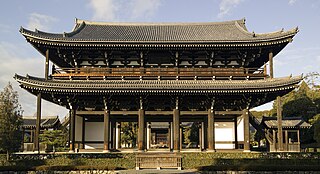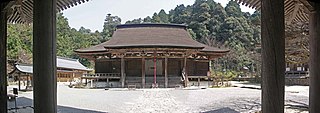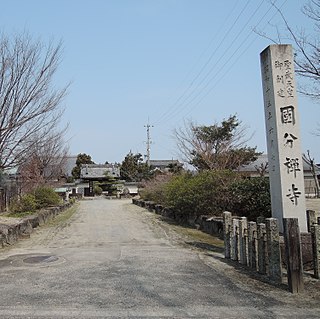
Yakushi-ji (薬師寺) is one of the most famous imperial and ancient Buddhist temples in Japan, and was once one of the Seven Great Temples of Nanto, located in Nara. The temple is the headquarters of the Hossō school of Japanese Buddhism. Yakushi-ji is one of the sites that are collectively inscribed as a UNESCO World Heritage Site under the name of "Historic Monuments of Ancient Nara."

Tō-ji Temple, also known as Kyō-ō-gokoku-ji is a Shingon Buddhist temple in the Minami-ku ward of Kyoto, Japan.

Kenchō-ji (建長寺) is a Rinzai Zen temple in Kamakura, Kanagawa Prefecture, Japan, which ranks first among Kamakura's so-called Five Great Zen Temples and is the oldest Zen training monastery in Japan. These temples were at the top of the Five Mountain System, a network of Zen temples started by the Hōjō Regents. Still very large, it originally had a full shichidō garan and 49 subtemples.

Sōji-ji (總持寺) is one of two daihonzan of the Sōtō school of Zen Buddhism. The other is Eihei-ji temple in Fukui Prefecture. Fodor's calls it "one of the largest and busiest Buddhist institutions in Japan". The temple was founded in 740 as a Shingon Buddhist temple. Keizan, later known as Sōtō's great patriarch Taiso Jōsai Daishi, founded the present temple in 1321, when he renamed it Sōji-ji with the help and patronage of Emperor Go-Daigo. The temple has about twelve buildings in Tsurumi, part of the port city of Yokohama, one designed by the architect Itō Chūta.

Buddhist temples or monasteries are the most numerous, famous, and important religious buildings in Japan. The shogunates or leaders of Japan have made it a priority to update and rebuild Buddhist temples since the Momoyama period. The Japanese word for a Buddhist monastery is tera (寺), and the same kanji also has the pronunciation ji, so temple names frequently end in -dera or -ji. Another ending, -in (院), is normally used to refer to minor temples. Examples of temple names that have these suffixes are Kiyomizu-dera, Enryaku-ji and Kōtoku-in.

Buddhism played an important role in the development of Japanese art between the 6th and the 16th centuries. Buddhist art and Buddhist religious thought came to Japan from China through Korea. Buddhist art was encouraged by Crown Prince Shōtoku in the Suiko period in the sixth century, and by Emperor Shōmu in the Nara period in the eighth century. In the early Heian period, Buddhist art and architecture greatly influenced the traditional Shinto arts, and Buddhist painting became fashionable among wealthy Japanese. The Kamakura period saw a flowering of Japanese Buddhist sculpture, whose origins are in the works of Heian period sculptor Jōchō. During this period, outstanding busshi appeared one after another in the Kei school, and Unkei, Kaikei, and Tankei were especially famous. The Amida sect of Buddhism provided the basis for many popular artworks. Buddhist art became popular among the masses via scroll paintings, paintings used in worship and paintings of Buddhas, saint's lives, hells and other religious themes. Under the Zen sect of Buddhism, portraiture of priests such as Bodhidharma became popular as well as scroll calligraphy and sumi-e brush painting.

Shichidō garan is a Japanese Buddhist term indicating the seven halls composing the ideal Buddhist temple compound. This compound word is composed of shichidō (七堂), literally meaning "seven halls", and garan (伽藍), meaning "temple". The term is often shortened to just garan. Which seven halls the term refers to varies, and 七堂 may be a misinterpretation of shitsudō (悉堂), meaning "complete temple". In practice, shichidō garan often simply means a large temple with many buildings.

A sanmon, also called sangedatsumon, is the most important gate of a Japanese Zen Buddhist temple, and is part of the Zen shichidō garan, the group of buildings that forms the heart of a Zen Buddhist temple. It can be often found in temples of other denominations too. Most sanmon are 2- or 3-bay nijūmon, but the name by itself does not imply any specific architecture.

Main hall or Main Temple is the building within a Japanese Buddhist monastery compound (garan) which enshrines the main object of veneration. Because the various denominations deliberately use different terms, this single English term translates several Japanese words, among them butsuden, butsu-dō, kondō, konpon-chūdō, and hondō. Hondō is its exact Japanese equivalent, while the others are more specialized words used by particular sects or for edifices having a particular structure.

The Japanese Buddhist pantheon designates the multitude of various Buddhas, Bodhisattvas and lesser deities and eminent religious masters in Buddhism. A Buddhist Pantheon exists to a certain extent in Mahāyāna, but is especially characteristic of Vajrayana Esoteric Buddhism, including Tibetan Buddhism and especially Japanese Shingon Buddhism, which formalized it to a great extent. In the ancient Japanese Buddhist pantheon, more than 3,000 Buddhas or deities have been counted, although now most temples focus on one Buddha and a few Bodhisattvas.

Japanese Buddhist architecture is the architecture of Buddhist temples in Japan, consisting of locally developed variants of architectural styles born in China. After Buddhism arrived from the continent via the Three Kingdoms of Korea in the 6th century, an effort was initially made to reproduce the original buildings as faithfully as possible, but gradually local versions of continental styles were developed both to meet Japanese tastes and to solve problems posed by local weather, which is more rainy and humid than in China. The first Buddhist sects were Nara's six Nanto Rokushū, followed during the Heian period by Kyoto's Shingon and Tendai. Later, during the Kamakura period, in Kamakura were born the Jōdo and the native Japanese sect Nichiren-shū. At roughly the same time, Zen Buddhism arrived from China, strongly influencing all other sects in many ways, including in architecture. The social composition of Buddhism's followers also changed radically with time. Beginning as an elite religion, it slowly spread from the nobility to warriors and merchants, and finally to the population at large. On the technical side, new woodworking tools like the framed pit saw and the plane allowed new architectural solutions.

Zenshūyō is a Japanese Buddhist architectural style derived from Chinese Song Dynasty architecture. Named after the Zen sect of Buddhism which brought it to Japan, it emerged in the late 12th or early 13th century. Together with Wayō and Daibutsuyō, it is one of the three most significant styles developed by Japanese Buddhism on the basis of Chinese models. Until World War II, this style was called karayō but, like the Daibutsuyō style, it was re-christened by Ōta Hirotarō, a 20th-century scholar. Its most typical features are a more or less linear layout of the garan, paneled doors hanging from hinges, intercolumnar tokyō, cusped windows, tail rafters, ornaments called kibana, and decorative pent roofs.
Pagodas in Japan are called tō, sometimes buttō or tōba, and derive historically from the Chinese pagoda, itself an interpretation of the Indian stupa. Like the stupa, pagodas were originally used as reliquaries, but in many cases ended up losing this function. Pagodas are quintessentially Buddhist and an important component of Japanese Buddhist temple compounds but, because until the Kami and Buddhas Separation Act of 1868, a Shinto shrine was normally also a Buddhist temple and vice versa, they are not rare at shrines either. The famous Itsukushima Shrine, for example, has one. After the Meiji Restoration the word tō, once used exclusively in a religious context, came to mean also "tower" in the western sense, as for example in Eiffel Tower.

Mon is a generic Japanese term for gate often used, either alone or as a suffix, in referring to the many gates used by Buddhist temples, Shinto shrines and traditional-style buildings and castles.

Dō. It is very often used in Japanese Buddhism as a suffix in the name of some of the many buildings that can be part of a Japanese temple compound. The suffix can be the name of a deity associated with it or express the building's function within the temple's compound.

Shōjō-ji (勝常寺) is a Buddhist temple of the Shingon-shu Buzan-ha sect in Yugawa, Kawanuma District, Fukushima Prefecture, Japan.

In Japan, a chinjusha is a Shinto shrine which enshrines a tutelary kami; that is, a patron spirit that protects a given area, village, building or a Buddhist temple. The Imperial Palace has its own tutelary shrine dedicated to the 21 guardian gods of Ise Shrine. Tutelary shrines are usually very small, but there is a range in size, and the great Hiyoshi Taisha for example is Enryaku-ji's tutelary shrine. The tutelary shrine of a temple or the complex the two together form are sometimes called a temple-shrine. If a tutelary shrine is called chinju-dō, it is the tutelary shrine of a Buddhist temple. Even in that case, however, the shrine retains its distinctive architecture.

Until the Meiji period (1868–1912), the jingū-ji were places of worship composed of a Buddhist temple and a Shinto shrine, both dedicated to a local kami. These complexes were born when a temple was erected next to a shrine to help its kami with its karmic problems. At the time, kami were thought to be also subjected to karma, and therefore in need of a salvation only Buddhism could provide. Having first appeared during the Nara period (710–794), jingū-ji remained common for over a millennium until, with few exceptions, they were destroyed in compliance with the Kami and Buddhas Separation Act of 1868. Seiganto-ji is a Tendai temple part of the Kumano Sanzan Shinto shrine complex, and as such can be considered one of the few shrine-temples still extant.

Saimyō-ji (西明寺), also known as Kotō-sanzan Saimyōji (湖東三山西明寺) or as Ryūōzan Saimyōji (龍應山西明寺) is a Buddhist temple of the Tendai sect located in the town of Kōra, Shiga Prefecture, Japan. The honzon of the temple is Yakushi Nyōrai, the Buddha of healing. The temple was founded in the early Heian period and together with Kongōrin-ji in Aishō and Hyakusai-ji in Higashiōmi the temple forms a group of three temples known as Kotō-sanzan. The complex includes several National Treasures and a garden designated as National Place of Scenic Beauty.

The Owari Kokubun-ji (尾張国分寺) is a Buddhist temple located in the Yawase neighborhood of the city of Inazawa, Aichi, Japan. The temple belongs to the Myōshin-ji branch of the Rinzai school of Japanese Zen. Its main image is a statue of Yakushi Nyōrai. It is the modern successor of one of the provincial temples established by Emperor Shōmu during the Nara period for the purpose of promoting Buddhism as the national religion of Japan and standardising control of Yamato rule over the provinces. The foundation stones of the original temple was designated as a National Historic Site by the Japanese government in 2012.

































































































